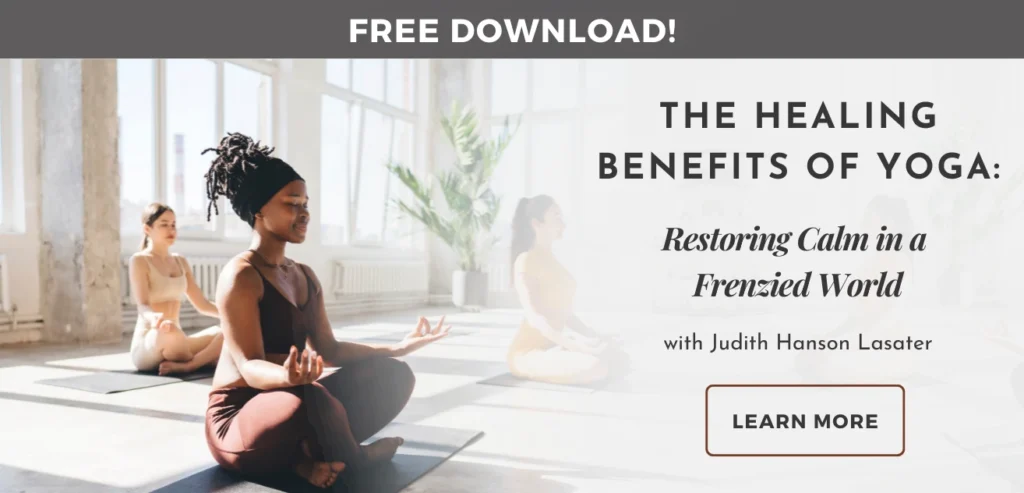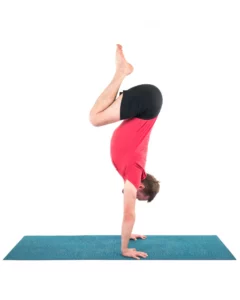Release Tight Shoulders with this Simple Shoulderstand Prep Pose

“It is no overstatement to say that if a person regularly practices Sarvangasana he will feel new vigor and strength and will be happy and confident. New life will flow into him, his mind will be at peace and he will feel the joy of life.” ~ B.K.S.Iyengar in Light on Yoga
Ah, Shoulderstand (Salamba Sarvangasana): the mother of asana, and not coincidentally, the creator of strong and flexible shoulders. But here’s the conundrum: if you have tight shoulders, it’s hard to do the pose.
It’s precisely the issue one of my students posed after class on Tuesday:
“I’m interested in your Shoulderstand commitment [to practice Shoulderstand every day], but I don’t think I can do it,” she said. “My shoulders are tight, so I need to do preparations, and if I don’t have time to do them, the pose won’t feel good or be good.”
How to Prepare for Shoulderstand with a Simple Shoulder Stretch
Today’s post offers a possible solution. It’s simple enough: you clasp your hands behind your back, roll your upper arms out, and straighten your arms. Then you move your inner shoulder blades deeper into your back ribs and down. It’s also surprisingly powerful.
All summer long I found myself doing this stretch, especially at times when other parts of my practice fell by the wayside. Sometimes I’d incorporate a standing forward bend, sometimes I’d reach my chest up and my head back and see how far I could take it into a backbend.
Then one day in the midst of a longer practice, I did Cow Face Pose (Gomukhasana). Imagine my surprise when my tight right shoulder, which seems to have been stuck in the same place for years, was suddenly not so tight. I was used to having my fingers just touch when the left arm was up and the right arm down. Suddenly, I could hook my fingers into each other with room to spare. More than that, this simple stretch has a direct relationship to the way we work our shoulders in Shoulderstand.
Shoulderstand Prep Pose
Clasp your arms behind you with your elbows bent and you are taking exactly the same arm position as you do when you prepare for Shoulderstand in Bridge Pose (Setu Bandha Sarvangasana) or in the clasped hands version of Plow Pose (Halasana).
In both cases, rotating the upper arms out, clasping the hands, and pressing them toward the floor creates active support for your neck and shoulders and prevents you from slumping in the pose.
So if you’re interested in making a daily yoga commitment, but not ready to commit to a daily Shoulderstand, this stretch is a great place to start. You’re welcome, of course, to add whatever other shoulder stretches you can work into your day—the more the merrier.
And if you’re not yet ready for a daily commitment, how about taking it on as a five-minute yoga challenge? In a five-minute yoga challenge, you’ve won if you do it three times in a week, and you’ve triumphed if you do it five times. Your shoulders will thank you.


How to Practice Shoulderstand Prep Pose
- Stand in Mountain Pose (Tadasana), feet hips-distance apart. Lift your front thighs and press the top three inches toward the bone. Keep your weight in your heels.
- Take your arms out wide at shoulder height. Roll your upper arms toward the ceiling.
- Moving slowly, keeping as much of the outward rotation of your arms as you can, clasp your hands behind your back, fingers web to web, but with space between your palms.
- With your elbows bent, roll your upper arms out again.
- Notice the outer edges of your shoulder blades moving slightly closer to your spine.
- Spend some time with your elbows bent, and focus on rolling your upper arms outward.
- Slowly straighten your arms and lift your hands away from your buttocks.
- Notice the inner edges of your shoulder blades. If your upper arms are well rotated, you should feel the inner edges of your shoulder blades pressing into the back of your ribcage.
- Very gently move the inner edges of your shoulder blades down. Make it a small movement. If you feel strain in your neck, you’re overdoing it.
- From the center of your sternum, widen your collarbones toward your shoulders. Roll your upper arms out. Lift your chest.
- Check that your thighs are lifting and pressing back, and your weight is in your heels.
- Relax your face, your eyes, and your throat.
- Hold for a minute or longer.
- Release your hands, and pause for a moment, feeling the release in your shoulders.
- Now repeat with the second clasp. To me, it feels like I move over one little finger; some teachers say “have the other thumb on top.” Repeat the stretch.
- When you’re done, relax your arms at your sides. Then slowly begin to lift them, with as little effort as possible. If you’ve held the stretch long enough, once your arms are past horizontal, they will float up on their own. Reach your arms overhead and enjoy the stretch in your side body.
Also, read...
In Celebration of Gray-Haired Yoga – Busting the Myth of the Yoga Body
Stand Firm: 6 Easy Balancing Moves for Your Daily Yoga Routine
Related courses

Eve Johnson taught Iyengar Yoga for 18 years before being introduced to Spinefulness in 2016. Convinced by the logic, clarity, and effectiveness of Spinefulness alignment, she took the teacher training course and was certified in July 2018. Eve teaches Spineful Yoga over Zoom and offers an online Spinefulness Foundations course. For course information, go to http://spinefulness.ca.



